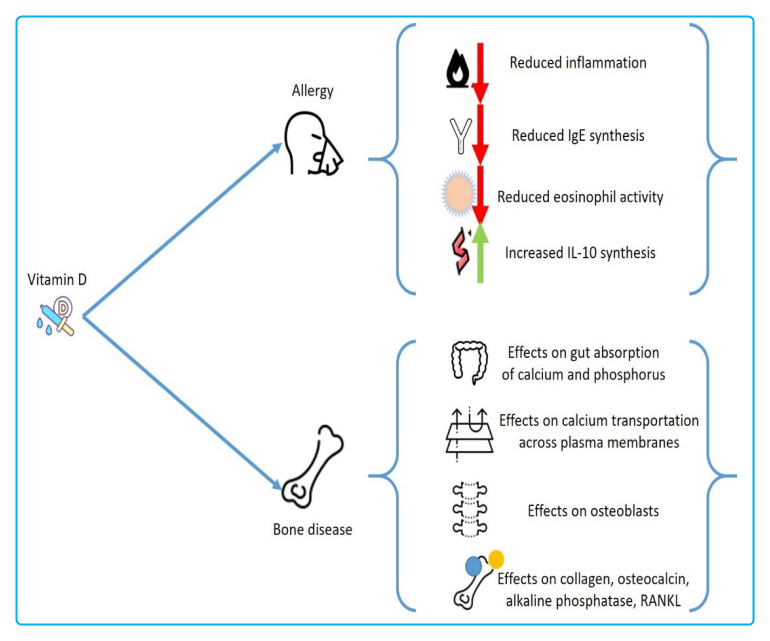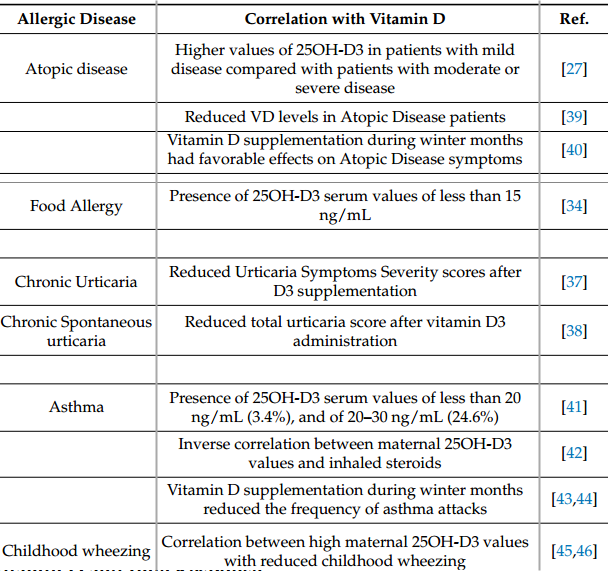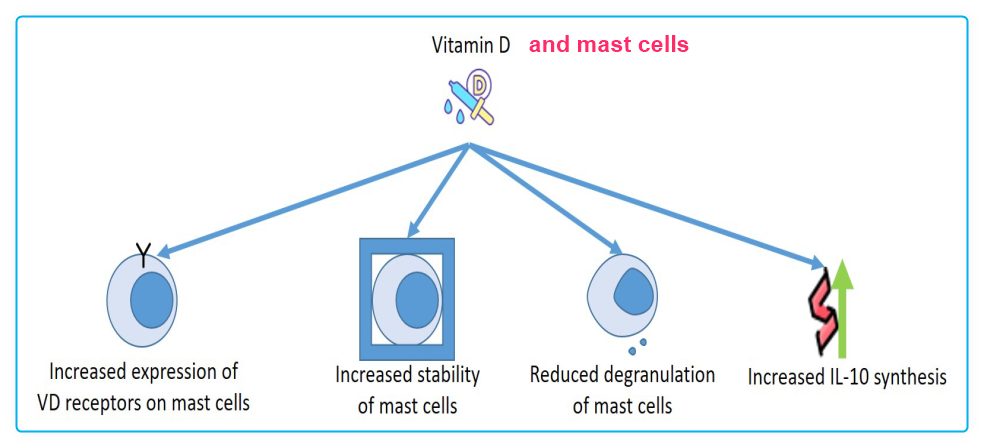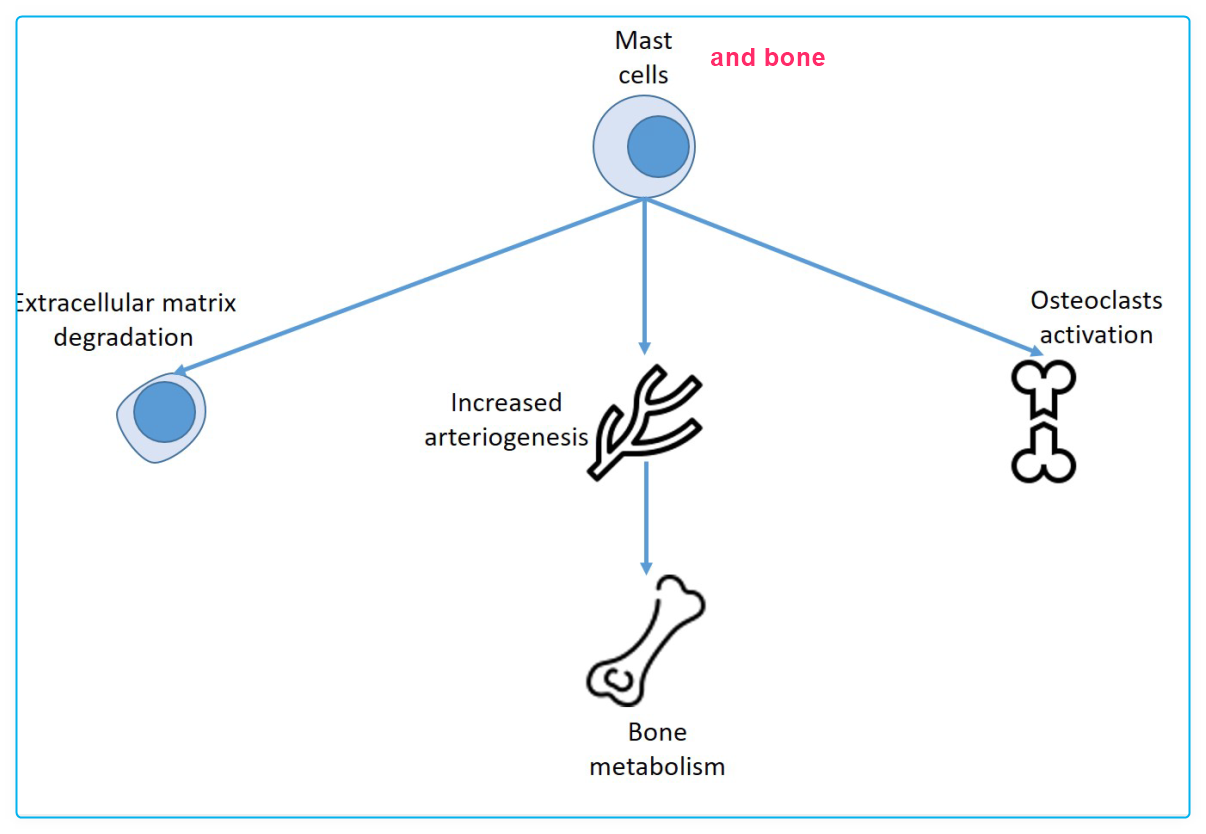Vitamin D, mast cells, bones, and allergies
Mast Cells and Vitamin D Status: A Clinical and Biological Link in the Onset of Allergy and Bone Diseases
Biomedicines 2022, 10(8), 1877; https://doi.org/10.3390/biomedicines10081877
by Giuseppe Murdaca 1,,†ORCID,Alessandro Allegra 2,,†ORCID,Alessandro Tonacci 3ORCID,Caterina Musolino 2,Luisa Ricciardi 4 andSebastiano Gangemi 4 ITALY






The immune system is made up by an extremely composite group of cells, whose regulated and harmonious activity is fundamental to maintain health. The mast cells are an essential effector of inflammatory response which is characterized by a massive release of mediators accumulated in cytoplasmic secretory granules. However, beyond the effects on immune response, mast cells can modify bone metabolism and are capable of intervening in the genesis of pathologies such as osteoporosis and osteopenia. Vitamin D is recognized to induce changes in bone metabolism, but it is also able to influence immune response, suppressing mast cell activation and IgE synthesis from B cells and increasing the number of dendritic cells and IL-10-generating regulatory T cells. Vitamin D deficit has been reported to worsen sensitization and allergic manifestations in several different experimental models. However, in clinical situations, contradictory findings have been described concerning the correlation between allergy and vitamin D deficit. The aim of this review was to analyze the close relationships between mast cells and vitamin D, which contribute, through the activation of different molecular or cellular activation pathways, to the determination of bone pathologies and the onset of allergic diseases.
📄 Download the PDF from Vitamin D Life
Is there an association between mast cells and Vitamin D? Asked Perplexity AI Dec 2024
Yes, there is a significant association between mast cells and Vitamin D. This relationship plays a crucial role in immune function, inflammation regulation, and mast cell stability.
Vitamin D's Impact on Mast Cells
Mast Cell Stabilization
Vitamin D has been shown to contribute to mast cell stabilization 1 7
When vitamin D binds to receptors on mast cells, it inhibits mast cell activation and helps stabilize these cells 1
This stabilization effect can lead to a reduction in the release of histamine and other inflammatory mediators, potentially alleviating symptoms associated with mast cell disorders. Immune Regulation
Vitamin D influences the immune response by suppressing mast cell activation and modulating the production of various immune components 3 6
It can promote the production of anti-inflammatory cytokines, such as IL-10, while reducing the release of pro-inflammatory mediators 2 4
Mechanisms of Action
Vitamin D Receptor (VDR) Interaction
Mast cells express vitamin D receptors (VDRs) 3 4
When vitamin D binds to these receptors, it initiates various cellular processes that contribute to mast cell stability and function regulation 7
. Molecular Pathways
Vitamin D influences several molecular pathways within mast cells:
It forms complexes with Lyn, inhibiting the binding of Lyn to FcεRI and MyD88 7
This interaction decreases the phosphorylation of Syk and reduces levels of MAPK and NF-κB 7
Vitamin D can also bind to the promoter of TNF-α, decreasing its expression in mast cells 7
Clinical Implications
Vitamin D Deficiency
Low levels of vitamin D may result in spontaneous mast cell activation 5 7
This suggests that maintaining adequate vitamin D levels is crucial for individuals with mast cell disorders or those prone to allergic reactions. Therapeutic Potential
The ability of vitamin D to stabilize mast cells and reduce inflammation presents potential therapeutic applications 2 6
Supplementation with vitamin D might be beneficial for individuals with mast cell activation syndrome, histamine intolerance, or other allergic conditions.
Research Findings
Studies have demonstrated that:
Vitamin D can increase IL-10 production in mast cells, which has anti-inflammatory effects 4
Mast cells can convert 25OHD3 to the active form of vitamin D (1α,25(OH)2D3), further contributing to their own regulation 6
UVB irradiation, which increases vitamin D production in the skin, can lead to mast cell-mediated reduction of skin inflammation, dependent on mast cell VDR expression 4
In conclusion, the relationship between mast cells and vitamin D is complex and multifaceted, with vitamin D playing a crucial role in mast cell stability, immune regulation, and inflammatory response modulation . This association underscores the importance of maintaining adequate vitamin D levels, especially for individuals with mast cell-related disorders.
Vitamin D Life – Bone - Health category contains
{include}
Vitamin D Life - Skin category contains
{include}
106+ Vitamin D Life pages with ALLERG in title
This list is automatically updated
{LIST()}
